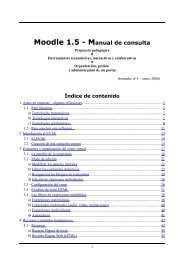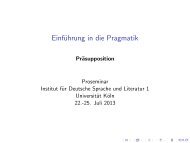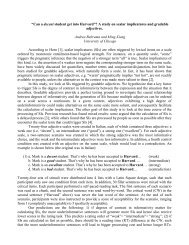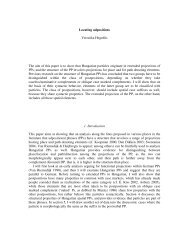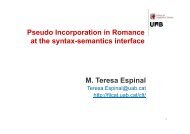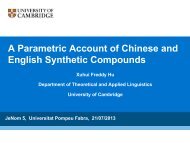Semantic aspects of differential object marking - corpora@parles.upf ...
Semantic aspects of differential object marking - corpora@parles.upf ...
Semantic aspects of differential object marking - corpora@parles.upf ...
Create successful ePaper yourself
Turn your PDF publications into a flip-book with our unique Google optimized e-Paper software.
<strong>Semantic</strong> <strong>aspects</strong> <strong>of</strong> <strong>differential</strong> <strong>object</strong> <strong>marking</strong> 11<br />
clauses but not in main clauses (see Dixon 1994 for discussion). As for fluid alternations, apart<br />
from definiteness and specificity, volitionality <strong>of</strong>ten plays a role such that the presence <strong>of</strong> certain<br />
case morphology indicates that the argument performed the action described by the verb in a<br />
volitional manner.<br />
Hindi and Kannada provide prime examples <strong>of</strong> languages in which a single case morpheme is<br />
involved in both a split and a fluid case alternation. Further research has to show whether there<br />
are also languages which show a similar pattern with respect to splits involving other features<br />
and what is the range <strong>of</strong> possibilities. An interesting case is found in Spanish in which more<br />
than one split alternation takes priority over a fluid alternation. In examples (5)–(8) above we<br />
have shown that the Spanish <strong>object</strong> marker a occurs with some but not other direct <strong>object</strong>s. The<br />
distribution <strong>of</strong> this marker has been extensively discussed in the literature but still is not entirely<br />
understood (for discussion, see Brugé and Brugger 1996, Torrego 1998, Delbecque 2002, von<br />
Heusinger and Kaiser 2003, Leonetti 2004, Bleam 2005). The occurrence <strong>of</strong> a follows an intricate<br />
pattern in which different split alternations and a fluid case alternation interact. First there<br />
is a split between animate and inanimate noun phrases in that only the former can take the <strong>object</strong><br />
marker. 6 Within the class <strong>of</strong> animate direct <strong>object</strong>s, the use <strong>of</strong> a is obligatory for what we<br />
could call syntactically definite <strong>object</strong>s such as proper names, pronouns, and NPs preceded by<br />
a definite article, a demonstrative, (certain) quantifiers, or possessives (see Brugé and Brugger<br />
1996 for discussion), but not for indefinite <strong>object</strong>s. Finally, there exists a split on the basis <strong>of</strong><br />
mood illustrated in (26) and (27):<br />
SPANISH (Romance; Bleam 2005:17)<br />
(26) Juan busca *(a) un estudiante que habla francés.<br />
Juan look.for A a student that speaks.INDIC French<br />
‘Juan is looking for a student who speaks French.’<br />
(27) Juan busca (a) un estudiante que hable francés.<br />
Juan look.for A a student that speaks.SUBJ French<br />
‘Juan is looking for a student who speaks French.’<br />
When an animate direct <strong>object</strong> is modified by a relative clause it has to be obligatorily preceded<br />
by a in case the finite verb in the relative clause is in the indicative (cf. (26)) but may be optionally<br />
preceded by a (given that it is an indefinite noun phrase) when the finite verb in the<br />
relative clause is in the subjunctive mood (cf. (27); see von Heusinger and Kaiser 2003:48-50<br />
for an overview; see also Bleam 2005:16-17). In the latter case the <strong>object</strong> can be interpreted as<br />
specific only when it is preceded by the <strong>object</strong> marker. The pattern in (26) in which the occurrence<br />
<strong>of</strong> a results in a specific interpretation and the absence <strong>of</strong> a does not is the general pattern<br />
for direct <strong>object</strong> for which a is not obligatory, i.e. indefinite and bare nouns. 7 In other words,<br />
Spanish shows a fluid case alternation on the basis <strong>of</strong> specificity in those cases where the use<br />
<strong>of</strong> the <strong>object</strong> marker is not required by one <strong>of</strong> the split case alternations. Thus, Spanish follows<br />
the pattern discussed above for Hindi and Kannada in which split alternations take priority over<br />
fluid alternations. Future research has to show whether this holds for other languages as well.<br />
6 The language is changing at this point though as the <strong>object</strong> marker is also intruding into the domain <strong>of</strong> inanimates<br />
(for discussion, see Delbecque 2002, Company 2002, Morimoto and de Swart 2006).<br />
7 As noted by Leonetti (2004) direct <strong>object</strong>s without a can only be interpreted as non-specific. Object which are<br />
preceded by a can be interpreted as both specific and non-specific. This is exactly the opposite pattern to that found<br />
in Hindi and Kannada.<br />
608<br />
11




